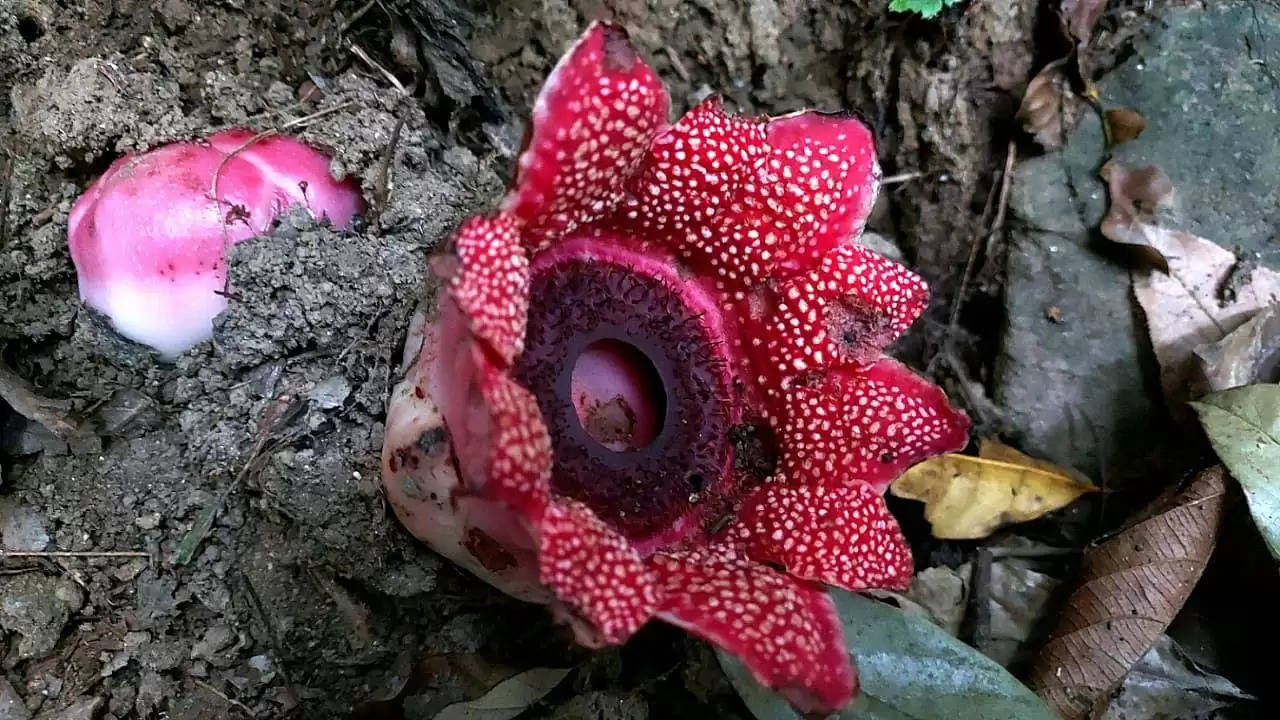Rare flower spotted in Garo Hills region of Meghalaya

WILLIAMNAGAR:
A rare flower documented only in parts of Arunachal Pradesh in India was first sighted in the Nokrek Biosphere, two kilometres away from Tura in Meghalaya’s West Garo Hills District.
This discovery has piqued the interests of several conservationists who are now calling for the protection of forests and the environment.
Sapria himalayana is a rare holo-parasitic flowering plant related to Rafflesia in the Eastern Himalayas.
The flower has been spotted in some parts of Arunachal Pradesh, and there have been records of it in parts of Assam, Manipur, Nagaland and Meghalaya.
However, there have been no recent sightings until now.
An employee in the taxation department in Williamnagar and an avid trekker, Bhuto Marak accompanied by a friend, had been on a recent trip on November 21 to the far-flung parts of the Nokrek Reserve.
As they neared the fringes of the Nokrek Peak, the two friends spotted a fully grown sapria himalayana. Surprised by the find, they immediately took photos of the place and the flower before informing the authorities.
Sapria himalayana is also the largest flower in the world. It has ten bracts and is bright red covered with sulphur-yellow spots. They appear above the ground, and the flowers are fleshy with imbricate inflorescence.
They, however, kept the location a secret for fear that visitors would overrun the place.
The flower’s discovery could lead to a frenzy which would lead to disturbances to the fragile environment required for its blooming, Marak said.
Also Read: Music: Sambok Mawnai releases new single “Digital World”
“The bud itself has only a 40-60 per cent chance of growing into a flower which only blooms for 2-3 days. We chose not to disclose the location as nature should heal itself and we felt the need to allow it time to do so,” he said.
According to Marak, the bud was still there when they spotted the flower and the friends decided on another trip to see if it had bloomed.
They also spotted three more buds in the same place where they found the flower.
“The flower requires forest litter to grow, and normal sightings have shown only one flower at a time. Sarpia has to be conserved in situ because of its parasitic nature. All efforts to grow the flower ex-situ have been futile,” he added.
Further, Marak felt that unauthorised and unproductive collection of specimens should not be encouraged; it lowers the chance of the flower’s survival.
“Too much damage has been done already. This is nature calling for it to be left alone so it can heal itself,” he said.
Meanwhile, another resident of Tura, Barnash D Shira, also reported sightings of the flower in another section of the Durama Range near Nokrek.
He had documented the same through a vlog. Others have reported sightings, though these were not verified.
International Union for Conservation of Nature (IUCN) lists the flower as endangered, mainly because of the environment required for it to grow. The flower grows in altitudes of 800 metres and above in evergreen forests but is found in only a few countries like Myanmar, Thailand, Vietnam and of course North-East India.
It is rare and is under threat because of anthropogenic pressures.
The flower has a history in Garo Hills which stems from the fact that they know it as ‘Dikge Pile’ in West Garo Hills and ‘Techri’ in East Garo Hills. The Nokrek Biosphere falls under both districts.
“This is a rare find, both for Botany enthusiasts and environmental experts. It also showcases the diversity of Garo Hills in its environment. This environment is crying for protection, and we must do everything possible to keep it right,” said Bhuto.
He added that the flora and fauna in the state, while less documented than the rest of the country, deserve as much protection as others with the hotspots of Balpakram and Nokrek in Garo Hills needing extra care.
The flower has three varieties, Griffith, poilanei and ram, with Griffith being the one spotted in the Nokrek Biosphere. It has until now only been found in Thailand and parts of Arunachal, with sightings being extremely rare.
The flowers are about 20 cm across, dioecious and unisexual. For its growth, the flower requires canopies and can be damaged by sunlight.
Flowering takes place between August and September, followed by fruiting during winter. After blooming, the flower dehisces (bursts open) and becomes dark and subsequently decomposes slowly. The seeds are of the size of a grapefruit and are blackish-brown.
Sapria himalayana represents the extreme manifestation of the parasitic mode, depending on its host plant for water, nutrients and products of photosynthesis which it sucks through a root system called haustoria. It attaches these haustoria to both the xylem and the phloem of the host plant.
Also Read: Crushing Stones for a Living: Plight of stone crushers of Meghalaya

















